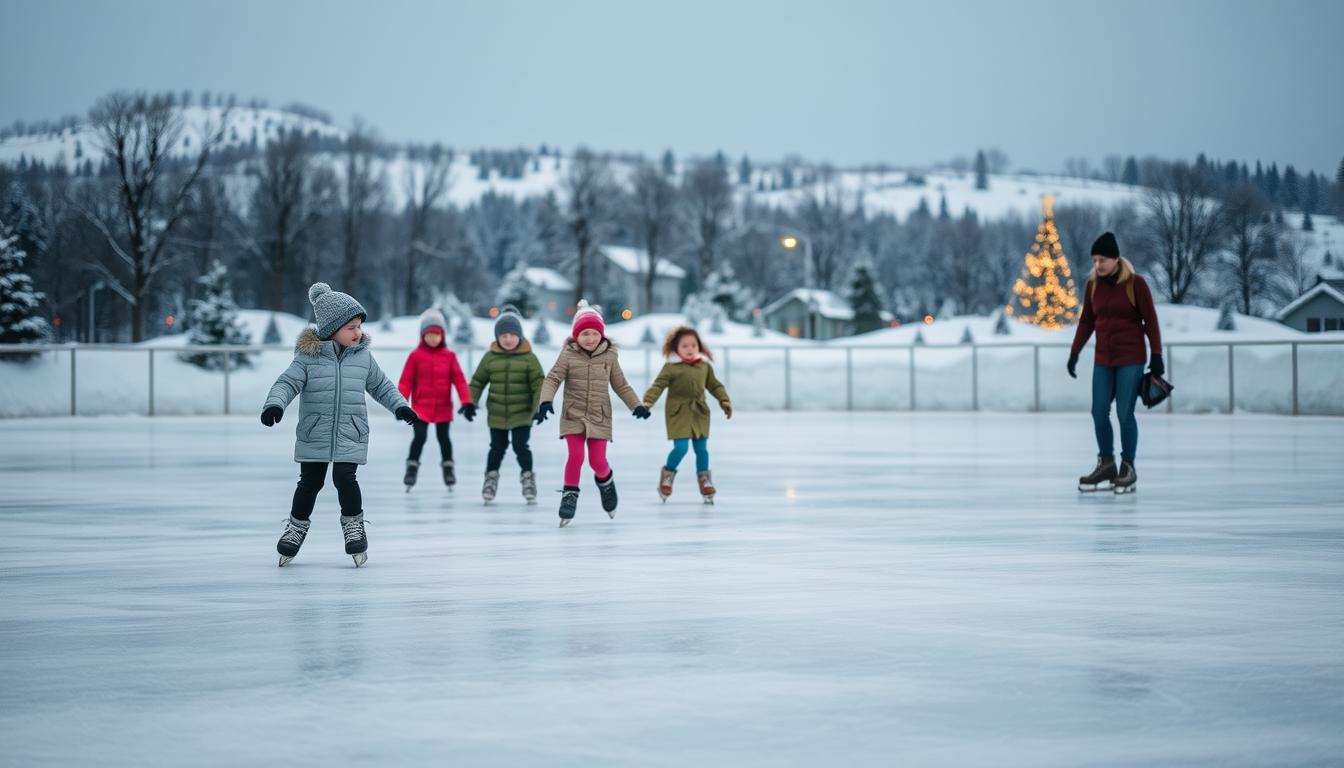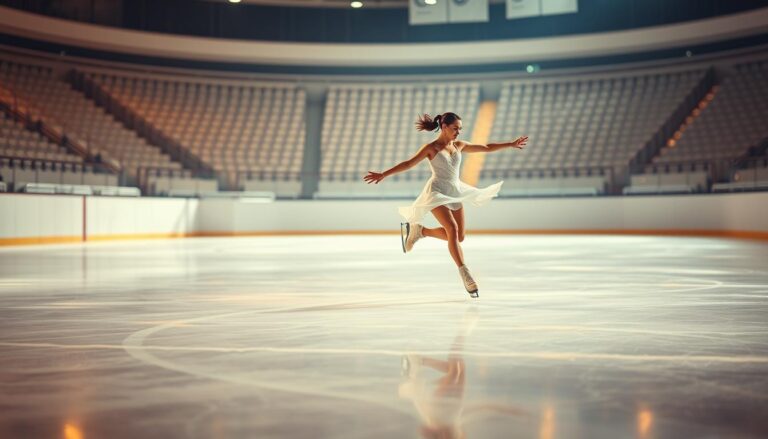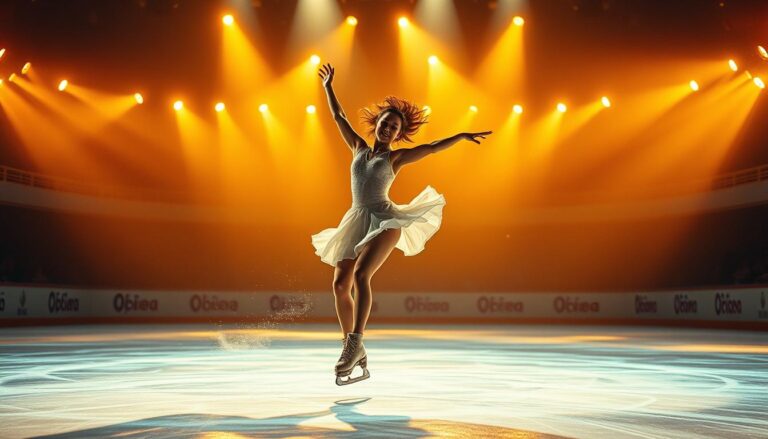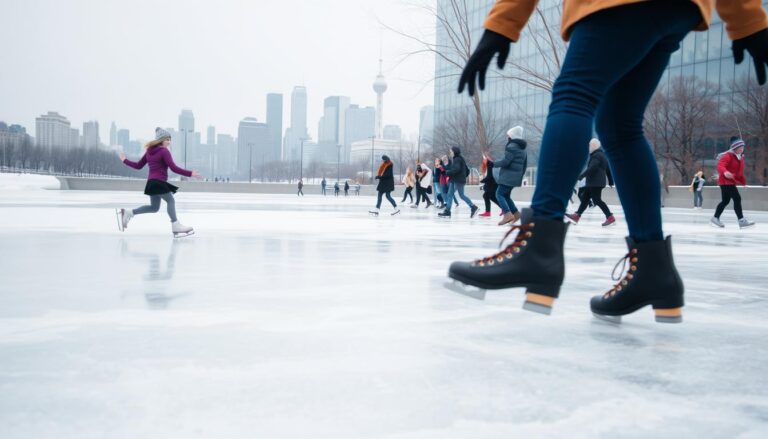The Ease of Ice Skating: Tips for Beginners
Ice skating might look scary at first, but it’s part of the fun for newbies. The ice invites you to try something new. It’s a mix of exercise, enjoyment, and learning new skills.
So, is ice skating easy for beginners? It’s a yes and no answer. At first, it might be tough, but with time, you’ll get the hang of it. You’ll go from shaky steps to smooth glides.
Ice skating is easier than you think. Modern rinks are set up to help beginners. They have great instructors, good equipment, and lessons to get you started.
Being fit helps a lot when you’re ice skating. You’ll work out your whole body, including your core and legs. You can even burn 250-500 calories per hour, depending on how hard you skate.
Staying safe is key when you’re new to ice skating. Wear helmets, wrist guards, and comfy clothes. Most rinks have classes that teach you the basics in easy steps.
Learning to skate starts with a few simple things. You need to balance, keep your weight right, and stand up straight. Every little success helps you get better and more confident.
Remember, everyone starts as a beginner. The ice skating world is friendly and ready to help. With the right mindset and a bit of practice, you’ll find ice skating fun and doable.
Understanding the Basics of Ice Skating
Starting ice skating is more than just being brave and balanced. It’s about learning the basics that let you glide on ice. Whether you’re new or want to improve, knowing the basics is key.
Physics Behind Gliding on Ice
Ice skating uses a cool science trick. When your blade hits the ice, it creates a thin water layer. This lets you move smoothly, making skating magical.
- Blade pressure melts a microscopic ice layer
- Reduced friction enables smooth movement
- Temperature and blade sharpness impact gliding
Essential Ice Skating Terminology
Knowing the right words helps you follow instructions better. Here are some terms every beginner should know:
| Term | Definition |
|---|---|
| Edges | Inside and outside curved sections of skate blade |
| Toe Picks | Serrated front part of figure skating blades used for jumps |
| Crossovers | Technique for changing direction and maintaining speed |
Types of Ice Skates
Choosing the right skates is important. Different types are for different skills and needs:
- Figure Skates: Made for artistic moves and jumps
- Hockey Skates: Short blades for fast, agile moves
- Recreational Skates: Good for beginners and casual skating
Learning these basics boosts your confidence and starts your ice skating journey. Remember, every pro started where you are now, eager to learn and explore ice skating.
Is Ice Skating Easy: Breaking Down the Learning Curve

Learning to ice skate isn’t as hard as many think. Most people can pick up ice skating quickly with the right mindset. It’s all about balance, coordination, and confidence, which anyone can improve with practice.
The learning curve for ice skating depends on a few things:
- Personal fitness level
- Age and flexibility
- Prior experience with balance sports
- Quality of instruction
Beginners might find the first few sessions tough, but they progress faster than they think. Most people start feeling comfortable on the ice within 2-3 skating sessions. The key is to stay relaxed, keep a positive attitude, and focus on the basics.
Professional skating instructors suggest these tips to learn quickly:
- Take beginner lessons from a qualified instructor
- Practice proper body positioning
- Start with basic balance exercises
- Use support structures like skating aids initially
Don’t worry about wobbling at first. Every skilled skater was once in your shoes. With regular practice and the right techniques, you’ll be gliding smoothly in no time.
Essential Equipment for Beginning Ice Skaters
Stepping onto the ice is more than just courage. The right gear makes your experience fun and safe. Choosing the right equipment is key for comfort and safety.
Choosing the Right Ice Skates
Finding the perfect ice skates is essential for beginners. Good skates support your feet, making you feel confident on the ice.
- Rental skates are great for first-timers
- Buy fitted skates for regular skating
- Look for skates with good ankle support and blade quality
Protective Gear Requirements
Safety is important when you start skating. Wearing protective gear helps prevent injuries and boosts your confidence.
| Protective Item | Purpose | Recommended for Beginners |
|---|---|---|
| Helmet | Head protection | Absolutely essential |
| Knee Pads | Joint protection | Highly recommended |
| Wrist Guards | Prevent wrist injuries | Strongly advised |
Proper Clothing Selection
Your clothes can greatly affect your skating experience. Layering is key to staying warm and moving easily.
- Wear moisture-wicking base layers
- Choose flexible, warm middle layers
- Select a lightweight, windproof outer layer
- Opt for warm, thin socks
Getting the right equipment is the first step to enjoying ice skating. Each piece of gear helps keep you safe, comfortable, and happy on the ice.
Preparing for Your First Ice Skating Session
Stepping onto the ice for the first time can feel intimidating. But with the right preparation, your first ice skating experience can be both fun and confidence-building. Learning how to start ice skating requires some strategic planning and mental preparation.
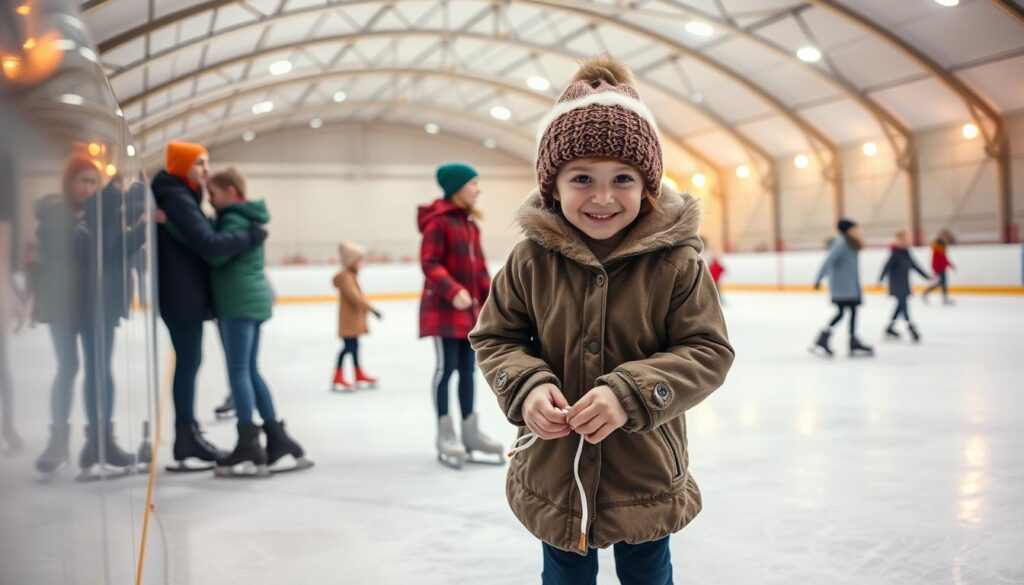
Before heading to the rink, consider these essential preparation steps for ice skating for beginners:
- Dress in layers for comfort and warmth
- Wear moisture-wicking clothing that allows easy movement
- Bring thick socks to prevent blisters
- Arrive early to get comfortable with the environment
Physical preparation is key for new skaters. Do some light stretching to warm up your muscles and improve flexibility. Focus on exercises that target:
- Leg muscles
- Core strength
- Balance and coordination
| Preparation Area | Key Actions |
|---|---|
| Physical Readiness | Stretching, light cardio, balance exercises |
| Mental Preparation | Watch beginner tutorials, visualize success |
| Equipment Check | Properly fitted skates, protective gear |
Pro tip: Choose less crowded skating times, like weekday mornings or early afternoons, for a more comfortable learning environment.
Remember, every professional skater started exactly where you are now. Embrace the learning process, stay patient with yourself, and enjoy the excitement of trying something new!
Proper Ice Skating Posture and Balance
Learning the right stance is key for beginners. It makes your skating smooth and confident. Simple techniques become easier with the right posture.
Your body’s position affects how well you glide and control on the ice. Imagine your body as a flexible column, ready to move with each step.
Body Alignment Techniques
Good body alignment includes several important points:
- Keep knees slightly bent (about 30-45 degrees)
- Maintain a straight back with a slight forward lean
- Align shoulders directly over your hips
- Look forward, not down at your skates
Weight Distribution Tips
Staying balanced is key for beginners. It’s a critical part of learning to skate.
- Center your weight between both feet
- Distribute weight on the middle of your skating blades
- Practice shifting weight smoothly between legs
Common Posture Mistakes
Avoid these common mistakes:
- Stiff legs: Creates instability and reduces mobility
- Looking down: Disrupts balance and increases fall risk
- Leaning backward: Prevents smooth forward movement
With practice, these techniques will become natural. You’ll skate with grace and confidence.
Basic Ice Skating Movements for Beginners
Learning easy ice skating tricks starts with understanding fundamental movements. Your first steps on the ice will build confidence and set the foundation for more advanced skills. These simple ice skating techniques will help you glide smoothly and control your motion.
New skaters should focus on mastering a few core movements that transform uncertainty into graceful motion. The following techniques will help you navigate the ice with growing confidence:
- Marching technique: Small steps to build balance
- Two-foot gliding: Developing stability on ice
- Basic pushing motion: Generating forward momentum
- Simple turns: Changing direction with control
Let’s break down these essential movements into manageable steps. The marching technique involves lifting each foot alternately, keeping your weight centered. This helps you get comfortable with skating’s unique feel and builds initial muscle memory.
| Movement | Difficulty Level | Practice Tips |
|---|---|---|
| Marching | Beginner | Keep knees slightly bent, arms relaxed |
| Two-Foot Gliding | Beginner | Maintain balanced weight distribution |
| Pushing Motion | Intermediate | Use inside edges of skate blades |
Practice these easy ice skating tricks with patience. Each small movement builds your skill and confidence on the ice. Remember that smooth, controlled motions are more important than speed when you’re learning simple ice skating techniques.
Safety Measures and Fall Prevention
Ice skating for beginners needs a good grasp of safety techniques. It’s as important as learning to skate. The right steps can turn accidents into chances to learn.
For beginners, safety always comes first. It’s about being ready for risks and surprises on the ice.
How to Fall Safely
Falling is part of learning to ice skate. The trick is to fall in a way that doesn’t hurt too much:
- Bend your knees and keep them slightly soft
- Avoid using your hands to break a fall
- Try to fall sideways or forward, not backward
- Aim to slide instead of landing hard
Getting Up After a Fall
Getting back up after a fall is key for beginners. Here’s how to do it smoothly:
- Roll onto your side
- Move to a kneeling position
- Place one skate between your hands
- Push yourself up slowly
- Regain your balance carefully
Avoiding Common Accidents
| Potential Hazard | Prevention Strategy |
|---|---|
| Overcrowded Rink | Skate during less busy times, stay aware of surroundings |
| Uneven Ice Surface | Watch for rough patches, maintain controlled gliding |
| Improper Equipment | Use well-fitted skates, wear protective gear |
Remember, confidence comes with practice. Each fall is an opportunity to learn and improve your ice skating skills.
Mastering Forward Skating Techniques

Learning to skate forward is key for anyone wanting to get good at ice skating fast. The secret to smooth skating is knowing the right techniques. These help you move easily across the ice.
Your body position is very important for good skating. Start by bending your knees a bit. This makes you stable and lets you move more powerfully. Keep your weight in the middle and your head up, looking ahead, not down.
- Position your feet shoulder-width apart
- Bend knees slightly for better balance
- Keep arms relaxed at your sides
- Push off with the inside edge of your skating blade
To skate forward well, learn the basic stride technique. Start by pushing off one foot backward while gliding on the other. Switch legs smoothly. This builds speed and confidence on the ice.
Good arm movement also helps your skating. Move your arms naturally, the opposite of your leg. This keeps you balanced and makes your movements smoother. As you get better, your skating will look more elegant and controlled.
- Start with short, controlled strides
- Gradually increase your speed and distance
- Practice consistent weight transfer between legs
- Focus on smooth, fluid movements
Remember, mastering forward skating takes time and effort. Don’t worry if you stumble or fall – every pro started where you are. Keep trying, and soon you’ll be gliding on the ice with ease.
Simple Stopping Methods for Beginners
Learning to stop on ice is key for beginners. It’s a skill that every new skater needs. These tips will help you control your speed and move smoothly on the rink.
Stopping on ice takes practice and the right technique. As a beginner, learning different methods will make you feel safe and in control.
Snow Plow Stop: Your First Stopping Technique
The snow plow stop is easy for beginners. Here’s how to do it:
- Glide forward with knees slightly bent
- Gradually turn your feet inward
- Push your heels out while keeping your toes together
- Apply gentle pressure to create friction and slow down
Pro tip: Practice this technique in a controlled area with plenty of space.
T-Stop Basics for Better Control
The T-stop is for those who want more control. To do it:
- Skate forward on your dominant foot
- Drag your other foot behind at a 90-degree angle
- Apply gentle pressure to the inside edge of the trailing foot
- Maintain balance and gradually reduce speed
Hockey Stop Introduction
The hockey stop is a bit harder but worth trying. It needs quick foot moves and sharp edge control. Beginners should start with basic stops before trying this.
Remember, getting better takes time. Focus on learning these stops and always stay safe on the ice.
Building Confidence on the Ice

Starting to learn ice skating can be scary for beginners. But, building confidence is the first step to becoming good at it. Is ice skating easy? Not always, but with the right mindset, you can pick it up fast and have fun.
Confidence on the ice comes from knowing you’re not alone. Everyone starts as a beginner. Your thoughts are as important as your physical skills when learning to skate.
- Visualize successful skating movements before stepping on the ice
- Practice positive self-talk to overcome initial fears
- Set small, achievable goals for each skating session
- Celebrate every improvement, no matter how small
Being mentally tough helps you face challenges. Remember that falling is part of the learning process. Even pros started where you are now – unsure but eager. Focus on getting better, not being perfect.
Here are some tips to boost your confidence fast:
- Take beginner lessons from a qualified instructor
- Practice in a supportive environment
- Wear protective gear to feel more secure
- Watch tutorial videos to understand techniques
Your ice skating journey is special. Be patient, stay dedicated, and trust the learning process. With regular practice and a positive attitude, you’ll go from a nervous beginner to a confident skater.
Common Beginner Mistakes to Avoid
Ice skating can be tough for beginners, but knowing common mistakes helps you get better faster. Every skater faces challenges, and knowing what to watch out for is key to getting better.
Balance-Related Errors
Keeping your balance right is key in ice skating for beginners. Many new skaters make simple posture mistakes. These mistakes can make it hard to stay stable and feel confident on the ice.
- Leaning too far forward or backward
- Keeping legs too stiff
- Looking down instead of ahead
- Tensing shoulders and upper body
Movement Misconceptions
Ice skating for beginners means learning the right way to move. Some common wrong ideas can make learning slower.
- Thinking you must lift feet high to move
- Trying to push hard instead of gliding
- Moving legs too much
- Moving stiffly without smooth motion
Equipment Mistakes
Choosing and using the right gear is key to good ice skating. Beginners often forget important gear choices.
- Wearing skates that are too loose
- Choosing the wrong skate size
- Not picking the right socks
- Not wearing protective gear
Remember, making mistakes is part of learning. Stay patient, keep practicing, and you’ll get better at ice skating.
Progressing Beyond Basic Skills
Once you’ve learned the basics, it’s time to try new skills. Learning ice skating quickly gets more exciting as you master advanced moves. These moves turn you from a beginner to a confident skater.
Getting to advanced skating means building on what you’ve learned. Easy ice skating tricks boost your confidence and add to your skills on the ice.
- Backwards skating techniques
- Crossover movements
- Basic figure skating turns
- Edge control skills
Different skating styles offer unique chances to improve. Figure skating is all about art, while ice dancing is about rhythm and teamwork. Each style brings its own challenges and rewards.
To improve fast, try these tips:
- Take lessons from experts now and then
- Practice often, aiming for 2-3 times a week
- Watch pro skating videos for tips
- Join skating clubs for more support
Your skating journey is all about getting better. Be patient, stay positive, and see every challenge as a chance to grow.
Recommended Practice Routines
Learning to ice skate starts with a good practice plan. You’ll build confidence and get better with time. It’s all about sticking to a routine.
For beginners, a solid routine is key. It turns you from a shaky beginner to a confident skater. Start with simple steps and slowly add more.
Beginner Practice Structure
- Warm-up (10-15 minutes)
- Gentle gliding
- Balance exercises
- Stretching on ice
- Skill Development (20-30 minutes)
- Basic forward skating
- Stopping techniques
- Turning and crossovers
- Free Skating (15-20 minutes)
- Practice learned skills
- Build confidence
- Enjoy the experience
How often you practice is just as important. Try to skate 2-3 times a week. This helps you get better faster.
| Practice Level | Duration | Focus Areas |
|---|---|---|
| Beginner | 45-60 minutes | Balance, basic movements |
| Intermediate | 60-90 minutes | Advanced techniques, endurance |
| Advanced | 90-120 minutes | Complex skills, performance |
Being consistent is the best way to learn ice skating. Every time you skate, you get closer to being a better skater.
Conclusion
Starting to ice skate might seem tough, but it’s easier than you think. Learning the basics and growing your confidence is key. With practice, patience, and persistence, you’ll get better.
Ice skating for beginners is all about having fun. You’ve learned important skills like how to stand right, move, and stay safe. Every time you skate, you’re getting better and enjoying it more.
At first, you might feel a bit shaky, but remember, pros started just like you. It’s important to enjoy every moment, learn from mistakes, and stay positive. This guide has given you the tools to have great times on the ice.
Begin your skating adventure with excitement and a willingness to learn. The ice is ready for your first confident step. So, put on your skates, use what you’ve learned, and start your journey. Your ice skating adventure begins today!
